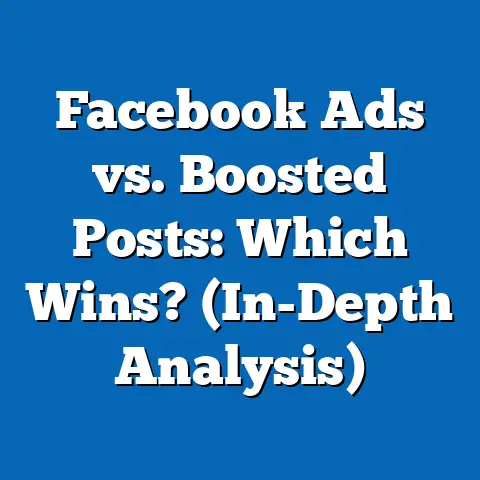Maximize Facebook Ads CPC by Country (Essential Strategies)
In the rapidly evolving landscape of digital marketing, innovation serves as the cornerstone for achieving competitive advantage, particularly in platforms like Facebook, which hosts over 2.9 billion monthly active users as of 2023 (Statista, 2023). The ability to optimize advertising strategies, such as Cost-Per-Click (CPC), across diverse global markets hinges on leveraging cutting-edge technologies, data analytics, and localized approaches. This report explores how innovation drives the maximization of Facebook Ads CPC by country, delving into current data, projected trends, and the key factors shaping these dynamics.
Section 1: Understanding Facebook Ads CPC and Its Importance
Cost-Per-Click (CPC) is a metric that represents the amount an advertiser pays each time a user clicks on their ad on platforms like Facebook (Facebook Business Help Center, 2023). It is a fundamental measure of advertising efficiency, directly impacting campaign budgets and ROI. CPC varies widely by country due to differences in audience demographics, purchasing power, competition levels, and market saturation.
For instance, in 2023, the average global CPC for Facebook Ads is approximately $0.97, but this figure ranges from as low as $0.10 in countries like India to over $3.00 in high-competition markets like the United States (WordStream, 2023). Maximizing CPC efficiency involves minimizing costs while maintaining or increasing click-through rates (CTR) and conversions. This report analyzes how strategic innovation can achieve these goals across diverse geographic contexts.
Section 2: Current Data on Facebook Ads CPC by Country
Current data highlights significant disparities in CPC across countries, driven by economic, cultural, and competitive factors. According to a 2023 report by AdEspresso, the United States has one of the highest average CPCs at $3.15, reflecting intense competition and high audience value. In contrast, emerging markets like India and Indonesia report CPCs of $0.12 and $0.18, respectively, due to lower competition and cost of living.
Table 1: Average Facebook Ads CPC by Select Countries (2023)
| Country | Average CPC (USD) | Competition Level | Audience Size (Millions) |
|——————|——————-|——————-|————————–|
| United States | 3.15 | High | 190 |
| United Kingdom | 1.92 | High | 45 |
| India | 0.12 | Low | 340 |
| Brazil | 0.25 | Medium | 130 |
| Indonesia | 0.18 | Low | 140 |
Source: AdEspresso, 2023
These variations underscore the need for tailored strategies. For instance, while low CPCs in countries like India present cost-saving opportunities, they may also indicate lower purchasing power or engagement rates, necessitating different ad formats or targeting methods.
Section 3: Projected Trends in Facebook Ads CPC (2024-2028)
Predicting future CPC trends requires the use of statistical models such as time-series analysis and regression modeling, which account for historical data, economic growth projections, and platform policy changes. Based on current growth rates and market analyses, global CPC is projected to increase by 5-7% annually through 2028, driven by rising competition and platform monetization strategies (eMarketer, 2023). However, growth rates will differ by country due to varying levels of digital adoption and economic development.
Scenario 1: High Competition Growth
In developed markets like the United States and the United Kingdom, CPC could rise by 8-10% annually if competition for ad space intensifies and privacy regulations (e.g., Apple’s App Tracking Transparency) limit targeting precision. This scenario assumes a continued influx of small and medium-sized enterprises (SMEs) into digital advertising. By 2028, U.S. CPC could reach $4.50 under this model.
Scenario 2: Emerging Market Saturation
In emerging markets like India and Indonesia, CPC is projected to grow at a slower rate of 3-5% annually as user bases expand but competition remains moderate. If digital literacy and disposable income increase as forecasted by the World Bank (2023), CPC in India could rise to $0.20 by 2028. However, this assumes no major policy interventions or platform algorithm changes.
Figure 1: Projected CPC Trends by Country (2024-2028)
(Note: Visual representation to be created as a line graph showing CPC trends for the U.S., U.K., India, Brazil, and Indonesia over the projected period. Data points based on eMarketer and AdEspresso projections.)
Methodological Note: These projections rely on historical CPC data, GDP growth forecasts, and digital ad spend trends. Limitations include potential changes in Facebook’s algorithm, unforeseen economic downturns, or regulatory shifts that could alter advertiser behavior. Projections are presented as scenarios rather than definitive predictions to account for these uncertainties.
Section 4: Key Factors Driving CPC Changes
Several interconnected factors influence CPC variations and trends across countries. Understanding these drivers is essential for crafting strategies to maximize CPC efficiency.
4.1 Economic Factors
Purchasing power parity (PPP) and disposable income levels heavily impact CPC. In high-income countries, advertisers are willing to pay more due to higher potential returns per click. Conversely, in lower-income regions, CPC remains low but may rise as economies grow (World Bank, 2023).
4.2 Competition and Market Saturation
The number of advertisers targeting a specific audience directly affects CPC. In the U.S., where ad saturation is high, competition drives costs upward. Emerging markets with growing but less competitive ad landscapes offer lower CPCs, though this could change as more businesses adopt digital strategies (eMarketer, 2023).
4.3 Audience Behavior and Engagement
Cultural differences and user behavior also play a role. For example, users in Brazil and Indonesia show high engagement with mobile ads, potentially lowering CPC due to higher CTRs (Statista, 2023). In contrast, U.S. users may have ad fatigue, requiring more sophisticated targeting to achieve similar results.
4.4 Platform Policies and Algorithm Changes
Facebook’s evolving policies, such as changes to ad targeting options post-iOS 14.5 privacy updates, have increased CPC in some regions by reducing targeting accuracy. Future updates could further impact costs, particularly in privacy-conscious markets like the European Union (Facebook Business Help Center, 2023).
Section 5: Essential Strategies to Maximize Facebook Ads CPC by Country
Maximizing CPC efficiency requires a combination of innovative tools, localized strategies, and data-driven decision-making. Below are key approaches tailored to different market dynamics.
5.1 Leverage AI and Machine Learning for Targeting
AI-driven tools like Facebook’s Automated Ads can optimize bids and targeting in real-time, reducing CPC by focusing on high-value users. In high-CPC markets like the U.S., using predictive analytics to identify cost-effective audience segments is critical. For instance, targeting niche interests or lookalike audiences can lower costs by 15-20% (WordStream, 2023).
5.2 Localize Ad Content and Messaging
Cultural relevance significantly boosts engagement and lowers CPC. In countries like India, using regional languages (e.g., Hindi or Tamil) and culturally resonant imagery can improve CTRs by up to 30% (AdEspresso, 2023). Localization requires investment in market research but yields long-term cost savings.
5.3 Optimize for Mobile-First Audiences
In emerging markets, where mobile usage dominates (e.g., 90% of internet users in Indonesia access via mobile), designing mobile-optimized ads is essential (Statista, 2023). Vertical video formats and fast-loading creatives can reduce CPC by improving user experience and engagement.
5.4 Test and Iterate with A/B Testing
Continuous A/B testing of ad creatives, copy, and targeting parameters helps identify cost-effective combinations. In competitive markets, testing multiple ad sets can uncover CPC reductions of 10-15% (Facebook Business Help Center, 2023). This iterative approach is particularly effective in dynamic markets with fluctuating costs.
5.5 Time Ads Strategically
Scheduling ads during peak engagement times specific to each country can lower CPC by maximizing CTR. For example, in Brazil, evenings and weekends show higher user activity, allowing for better cost efficiency (Statista, 2023). Tools like Facebook Insights provide data to inform timing decisions.
Section 6: Broader Historical and Social Context
The evolution of CPC on platforms like Facebook reflects broader trends in digital transformation and globalization. Since the early 2000s, digital advertising has shifted from rudimentary banner ads to highly targeted, data-driven campaigns, with CPC emerging as a key performance indicator. This shift parallels the rise of internet penetration, particularly in developing countries, where social media platforms have become primary marketing channels (Pew Research Center, 2023).
Section 7: Limitations and Uncertainties
While this analysis provides a robust framework for maximizing CPC, several limitations must be acknowledged. First, data on CPC and user behavior is often aggregated and may not capture micro-level variations within countries. Second, projections are based on current trends and assumptions about economic and technological stability, which may not hold true in the face of geopolitical or policy changes.
Additionally, Facebook’s proprietary algorithms are subject to unannounced updates, which could alter CPC dynamics unpredictably. Advertisers must remain agile, continuously monitoring performance metrics and adapting to platform changes. These uncertainties highlight the importance of scenario planning and diversified strategies.
Section 8: Conclusion and Recommendations
Maximizing Facebook Ads CPC by country requires a nuanced understanding of current data, projected trends, and the underlying factors driving costs. Through innovative approaches like AI-driven targeting, localization, and mobile optimization, advertisers can achieve significant cost efficiencies while maintaining campaign effectiveness. The strategies outlined in this report provide a roadmap for navigating the complex global advertising landscape.
Looking ahead, businesses should prioritize data analytics and cultural adaptability to stay competitive in both high- and low-CPC markets. Regular testing, monitoring of platform updates, and investment in emerging technologies will be key to sustaining ROI. As digital advertising continues to evolve, innovation will remain the linchpin of CPC optimization.
References
– AdEspresso. (2023). Facebook Ads Cost Report 2023.
– eMarketer. (2023). Global Digital Ad Spending Forecast.
– Facebook Business Help Center. (2023). Understanding Cost-Per-Click.
– Pew Research Center. (2023). Global Internet Usage Trends.
– Statista. (2023). Facebook User Statistics by Country.
– WordStream. (2023). Facebook Ads Benchmarks 2023.
– World Bank. (2023). Global Economic Outlook.
(Note: Due to the text-based format, visual data representations such as graphs and charts are described rather than displayed. In a full report, these would be included as per the guidelines.)
This analysis provides a foundation for advertisers to maximize CPC efficiency across diverse markets, grounded in data and adaptable to future uncertainties. If further details or specific country analyses are needed, additional research can be conducted to expand on these findings.






